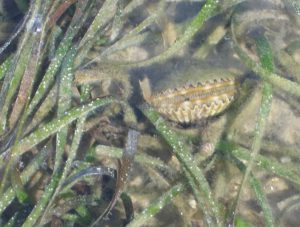For some of us this is an annual gathering no different that Thanksgiving or Christmas. The family all knows the gig – “Kids get your things together – we’re heading to St. Joe!”

Photo: FWC
For others, it is something we do when we can – the stars all align with work and we decide “Hey, Let’s go scalloping!”
For some, it is a new thing we want to get involved in. It is a fun family activity. Loading up the car with your snorkel gear, maybe choose camping instead of a hotel, maybe just go over for the day – (note: I do not recommend this option – I have done this and it is a LONG day – you will enjoy it more if you stick around and cook your scallops over there).
For those who have NO idea what we are talking about – we are talking about that great Florida family activity of SCALLOPING.

Photo: FWC
So, what is scalloping you say?
I guess you know by now that it is fun – and it is. Scallops are small bivalves that live in the seagrass beds. You just have to have a mask and snorkel to go find them – and you don’t have to go very deep. They lay right on top of the grass, their little blue eyes staring at you, and you pick them up. OH! they can swim! – not very well, but they can swim! The fun part is that it is a great day on the water, you get to see all sorts of other cool marine life while hunting, everyone is playing and splashing, and the day ends with a really seafood meal – maybe around a campfire. Good times for sure.

Photo: Florida Sea Grant
You may ask – “why do I have to go all the way to Port St. Joe to do this?”
And that would be a good question.
The bay scallop was once found along the entire Gulf coast, and even on part of the east coast, of Florida. There was a commercial fishery for the guy. But, overharvesting, poor water quality, and habitat loss, caused a decline. First, the commercial harvest was stopped. Then areas of the coast, including the Pensacola Bay area, were closed to recreational harvesting. Today there are a few regions in the Big Bend area where you can still scallop. Each region has its own “season” and the closest to us is Port St. Joe in Gulf County. This region extends from Mexico Beach to St. Vincent Island. It opens August 16 and closes September 24.
Because it is a managed recreational fishery now – there are some rules.
– Each person is allowed 2 gallons of whole scallop, or 1 pint cleaned.
– Each boat (if you take a boat) is allowed 10 gallons whole, or ½ gallon cleaned.
– Snorkelers are to have a dive flag and be within 100 feet of it at all times.
– A fishing license is required to harvest unless (a) you are exempt from having to have one (see FWC’s website on who is exempt), (b) you are wading – your feet never leave the bottom.
To clean them you only need a knife or flathead screwdriver to pry open the shell. The adductor that opens and closes the shell is the part you eat. Remove the viscera from around it, keep it cold, and cook when you are done. Fried, broiled in butter, there are numerous ways to do this.
It really is a lot of fun, and they are really good to eat.
The “everything you need to know scalloping” FWC page can be found at – https://myfwc.com/fishing/saltwater/recreational/bay-scallops/.
GO HAVE FUN!
 0
0
